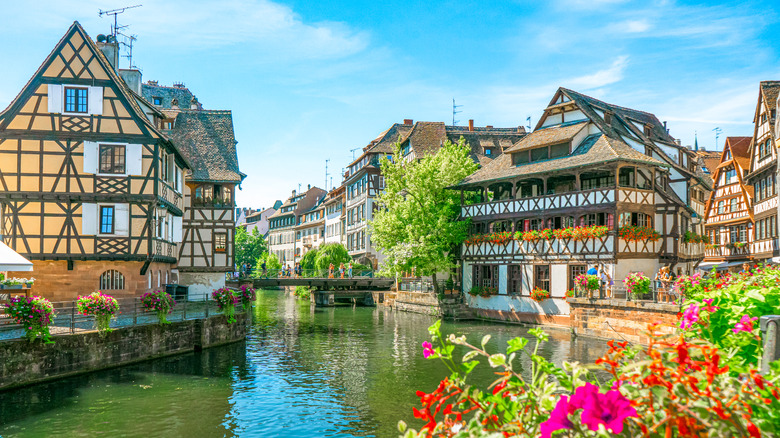Dance Between German And French Cultures At This Inviting, One-Of-A-Kind Riverfront City
One of the best parts of traveling through Europe is how easy it is to hop from one country to another, allowing one to do brag-worthy things like having breakfast, lunch, and dinner in three different countries. The continent has several "crossroads" — cities, localities, or specific points that straddle multiple nations. The Drielandenpunt, for example, is a monument at the crossroads of Belgium, Germany, and the Netherlands. The city of Strasbourg, on the border of France and Germany, embodies this overlap better than most places because it is more than just a geographical quirk. It is a city where German and French culture, language, architecture, and even food seamlessly blend.
Strasbourg is flanked by Germany's iconic Black Forest on one side and the French Vosges mountains on the other. Even the street signs here are in both French and German dialects. The city's dual culture is a result of a rich and occasionally tumultuous history, and worth exploring for any traveler intrigued by Europe's complicated past.
Strasbourg has a lot to offer to tourists, including quaint museums, an old city center that's a UNESCO World Heritage Site, and the imposing Notre Dame cathedral that was built over three centuries. You'll also get traditional French and German food, but don't forget these tips for dining like a local in France while digging in. After all, Strasbourg is a French city, even though that hasn't always been the case.
Strasbourg has been part of both France and Germany
Situated strategically on the Rhine, Strasbourg has oscillated between France and Germany multiple times, seeing both prosperity and destruction. Back in the 13th century, it was a fortified German city and trading post that Louis XIV of France then annexed in the 17th century. The Franco-German war in 1870 resulted in the city once again becoming German, and the subsequent world wars saw Strasbourg change hands multiple times.
The city also suffered severe damage over the years, and parts of it were rebuilt by whichever country it belonged to, giving it an eclectic mix of architecture. And iconic events connected to both countries have occurred in Strasbourg. It is the city where, in 1440, the German inventor Johannes Gutenberg revealed his plans for the modern printing press, which revolutionized literary and artistic movements. The French national anthem was also born here in 1792.
At the end of World War II, Strasbourg was transferred from Nazi control and became a part of France again. Because of its multicultural past, the city was made one of the capitals of the modern European Union, a position it still holds. It is, therefore, home to the European Court of Human Rights and the European Parliament of the European Union. The latter can be visited and offers an interesting peek into the dynamics of European integration.
Strasbourg is a charming tourist destination worth visiting
Strasbourg is worth visiting for several reasons, including the city's rich history, apparent in many different aspects. It is also a great option for those traveling solo through Europe since it is small enough to not feel lost or overwhelmed in but still lets you explore two of the continent's most prominent cultures. Yet while there are useful phrases to know while traveling through France, you'll find people speaking French, German, English, and the local Alsatian in Strasbourg, making it relatively easy for English speakers to get around.
You can marvel at the different types of architecture as you walk through the winding lanes of Strasbourg's Old Town, a UNESCO World Heritage Site. Within it is Petite France, a district dotted with medieval half-timbered houses that will take you back to the 16th and 17th centuries.
Other unmissable attractions include the Notre Dame Cathedral, which is one of France's best examples of Gothic architecture and survived despite the heavy damage the city bore during multiple wars. The building's gorgeous stained glass windows have an interesting history, having made their way across France and Nazi Germany during the Second World War before finally being recovered and installed in the cathedral. Strasbourg's Historic and Alsatian museums also reflect the city's character, and both are in buildings that feature stunning local architecture, with the latter housed in what was one of the city's oldest residences.


